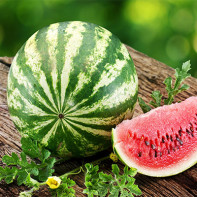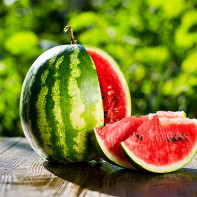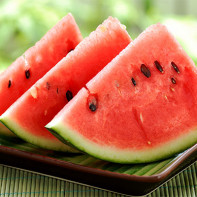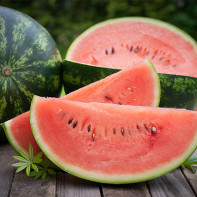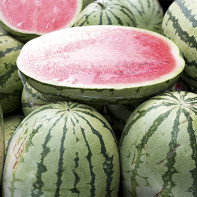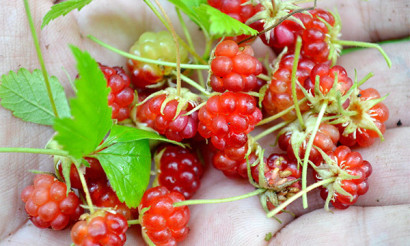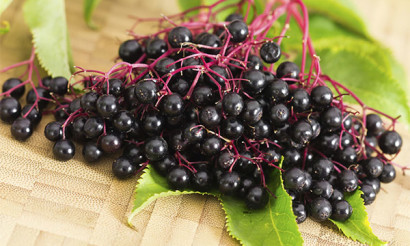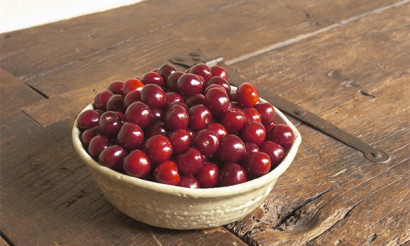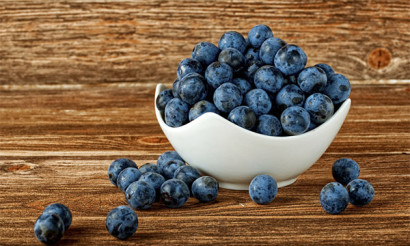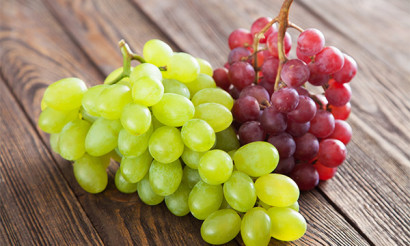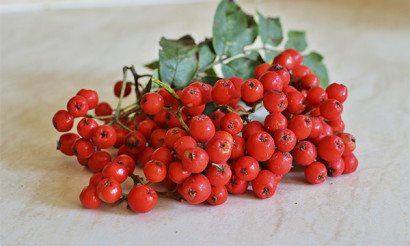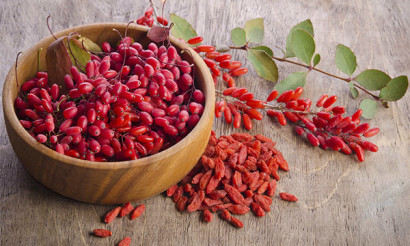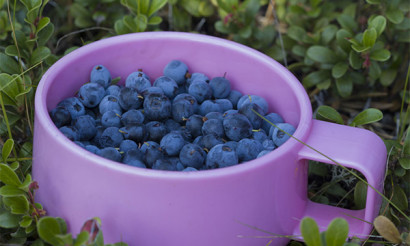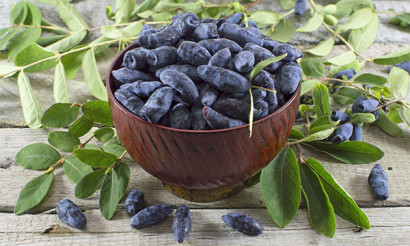Watermelon: health benefits and harms
Watermelon is a large and sweet berry that most people love for its refreshing taste. But, in addition, it is an unusually useful product. When used correctly, it will help to improve health and even get rid of extra pounds.
- What is the difference between yellow watermelon and red
- Which is more useful
- Composition and calorie content
- What is useful watermelon
- General benefit
- For women
- For men
- During pregnancy
- When breastfeeding
- For kids
- The benefits of watermelon peel
- Watermelon seeds: benefits and harms
- Watermelon oil: properties and applications
- Is it possible to eat watermelon while losing weight
- Watermelon in medicine
- With diabetes
- With pancreatitis
- With gastritis
- For the intestines
- For constipation
- With gout
- With colitis
- For the liver
- With hemorrhoids
- With cholecystitis
- In case of poisoning
- Watermelon in cosmetology
- For face
- For hair
- Harm and contraindications
- Symptoms of watermelon poisoning
- How to choose a ripe and sweet watermelon
- How to check for nitrates
- How to store watermelon
- Is it possible to freeze
- How to eat a watermelon
- How much can you eat per day
- Can I eat at night and on an empty stomach
- Is it possible to eat watermelon seeds
- Is it possible to eat watermelons in July
- What can be made from watermelon: recipes
- Jam
- Compote
- Ice cream
- Wine
- Pickled Watermelon in Jars
- Is it possible to give animals a watermelon
- Interesting facts about watermelon
What is the difference between yellow watermelon and red
From a biological point of view, yellow watermelon belongs to the same variety as the usual one with red flesh. It is the fruit of selection, in which an ordinary watermelon was crossed with its wild variety, which has yellow but unsweetened flesh. For farmers, it is interesting for its earlier maturation.
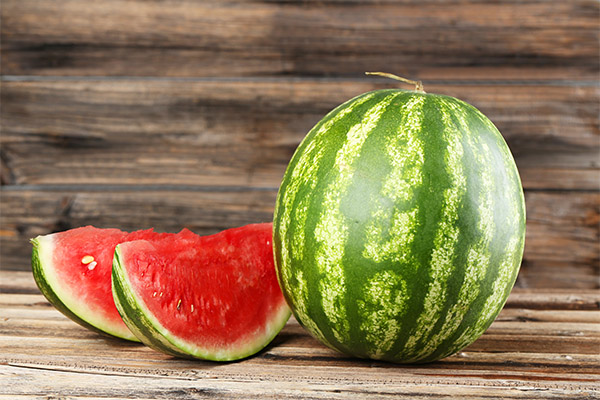
Its difference from the red variety lies not only in the color of the flesh, but also in the fact that there are practically no seeds or much less of them. In addition, it has a very dry and hard crust, from which it will not work to cook candied fruits or make jam. But such a watermelon costs about twice as much as a regular one - this is more likely due to its rarity and marketing features, but not its qualities.
Which is more useful
It is impossible to answer unequivocally the question of what kind of watermelons are more useful, since they have approximately the same chemical composition. That is, yellow watermelon also contains fiber, vitamins, essential amino acids and minerals. However, it contains slightly more fibers. And, in addition, the flesh of this watermelon is distinguished by exotic notes of taste - it can resemble mango, pineapple or citrus fruits (though sometimes a pumpkin). With this in mind, some people find yellow watermelon more useful, because of the faster ripening, there is less risk of using nitrates in the growing process.
On the other hand, it has few seeds, and its peel does not contain those useful elements that are found in red watermelon. So from the point of view of utility, we can consider them the same.
Composition and calorie content
Watermelon is a berry that is low in calories. Its energy value on average is only 38 kcal per 100 g of pulp. This is not surprising, because watermelon is about 92–93% water. But then everything else is exclusively useful substances:
- Vitamin A, which is an important antioxidant and is also good for vision.
- Vitamins B1 and B6, which are involved in metabolic processes, as well as normalize the functions of the nervous system.
- Vitamin E is another powerful antioxidant that is especially important for reproductive function.
- Folic acid (vitamin B9), which is also useful for cognitive functions.
- Vitamin C is also an antioxidant and at the same time strengthens the walls of blood vessels and helps increase immunity.
- Essential amino acids, including arginine and citrulline, which will be discussed below.
- Macro and micronutrients, including manganese, potassium, magnesium, etc.
And while the watermelon does not contain harmful fats and cholesterol, as well as sodium, which could level this excellent chemical composition.
What is useful watermelon
General benefit
The longer scientists study watermelon, the more evidence appears that it is useful. After all, the use of this berry allows you to:
- improve blood circulation;
- normalize blood pressure;
- reduce fat accumulation;
- cleanse the kidneys of accumulated toxins.
Due to its electrolyte composition, watermelon pulp and juice prevent dehydration, and even refresh even in the most intense heat.
For women
For the fair sex, watermelon is primarily useful for its high content of antioxidants, which slow down the aging process. In addition, these substances have anti-inflammatory properties, which helps prevent many diseases of the pelvic organs.
Thanks to the light diuretic effect, watermelon allows you to get rid of puffiness, and with it, extra pounds. A high content of vitamin C improves blood circulation and prevents venous congestion, which is dangerous because it can lead to varicose veins.
Finally, the vitamin E contained in the pulp of watermelon is very beneficial for the reproductive system.
For men
Sometimes watermelon is called natural viagra. And doctors have reason to make such a comparison. The fact is that watermelon contains the amino acids citrulline and arginine. These compounds are involved in the synthesis of nitric oxide. The latter plays the role of a kind of signaling molecule and an analogue of the hormone, performing many functions. It regulates blood pressure, normalizes the activity of the nervous system, and also dilates blood vessels and relaxes the smooth muscles of their walls. That is, this substance, in principle, performs the same tasks as Viagra, that is, it improves erectile function and has a beneficial effect on the reproductive system.
At the same time, watermelon pulp is devoid of side effects characteristic of Viagra. That is why watermelon is so useful for men. In addition, it contains many antioxidants, of which lycopene is considered the most important for representatives of the strong half of humanity. This is a carotenoid pigment, it is he who gives the pulp a red tint. In watermelon it contains twice as much as in tomatoes, which doctors advise to use to protect against prostate cancer. So watermelon pulp containing a large amount of lycopene prevents cancer of the prostate gland, fights inflammatory processes in the body, and strengthens the immune system.
During pregnancy
Watermelon contains a lot of folic acid, which is considered very useful for expectant mothers, since this compound helps prevent malformations in the child. In addition, the pulp of this large berry contains a lot of vitamin C, which is necessary for strengthening vessels. Iron is also present in it, a lack of which in the diet can cause anemia. And watermelon pulp also contains calcium, which is necessary for the formation of bones - during the period of gestation, this element is often not enough. So in the early stages of pregnancy, watermelon is very useful.

In the second trimester, watermelon is good because, thanks to the diuretic effect, it helps to avoid edema, which for a future mother is fraught with a strong increase in blood pressure. In addition, it improves kidney function.
Finally, watermelon is a low-calorie delicacy, it quenches hunger and thirst well and at the same time does not lead to the appearance of extra pounds. If there are no contraindications, then you can even arrange fasting days on a watermelon, dividing 1-1.5 kg of pulp into six meals.
If there is diabetes mellitus (including gestational) or kidney stones, then watermelon is contraindicated during pregnancy. This also applies to cases of very severe puffiness with poor kidney function.
Finally, in the last stages of pregnancy, the use of watermelon in large quantities can cause false contractions, so you need to refrain from it at all, if you can not limit yourself to one slice.
When breastfeeding
Usually, pediatricians advise to follow a simple rule when forming a diet for a nursing mother — if the mother has no and never had a reaction to some product, then the child most likely will not have it. But you need to start using this product with a small amount to check the baby’s reaction during the day.
This also applies to watermelon. It is very useful for a young mother, because it allows you to lose weight gained during pregnancy and improve the condition of the skin, hair and nails. At the same time, you need to start using it with a small piece, if there is no reaction during the day, you can increase the amount to 3-4 cloves. It is not worth consuming more, but for other reasons. If red spots of urticaria appeared on the skin of a child, then you need to analyze what else mother ate that day, perhaps the question is in the combination of products. After a couple of days, you can repeat the experiment. If there is no reaction, then you can already fully introduce the product into the diet.
Why watermelon can not be consumed in large quantities - this issue is of interest to many young mothers. The thing is that with unlimited use of watermelon, even in an adult, it most often provokes increased gas formation, let alone a child who may suffer from colic.
Some pediatricians even believe that a young mother can include watermelon, like any other products that provoke gas formation, only after the baby is two months old. But this is just a recommendation, and not a strict rule, especially since the watermelon season is passing so quickly. So you need to focus solely on the condition of the baby.
For kids
For kids, watermelons are just as good as for adults. Delicate dietary fiber contained in the pulp of this berry helps to establish digestion, which is especially important if the baby has a tendency to constipation. Due to the diuretic effect, watermelon is often recommended for heart failure. A high iron content will be beneficial for those who suffer from anemia or frequent nosebleeds. And the watermelon diet is prescribed for those babies who have problems with being overweight.
However, it is better not to give watermelon to young children, and babies at 3 years old can only be given a small amount, provided that these berries are carefully checked. Children react to nitrates much worse than adults.
The benefits of watermelon peel
Watermelon peels contain many beneficial substances. This, for example, the citrulline amino acid mentioned above, which is necessary for the expansion of blood vessels and relaxation of smooth muscles. In crusts, it is present even in larger quantities than in the pulp itself.
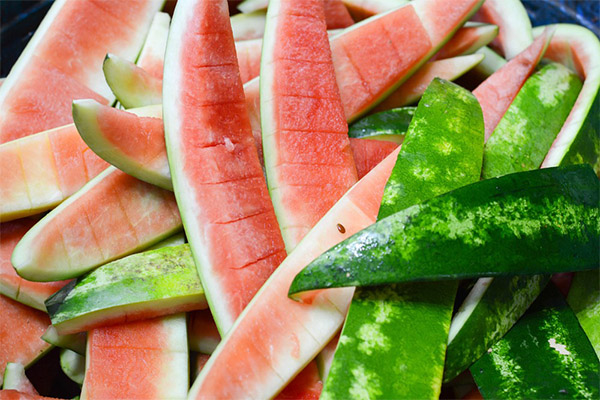
Watermelon peels, previously well dried, are considered an effective remedy for nephritis and puffiness. The hardest top layer is cut from them, and the softer light part below it is crushed in any convenient way and sent to the oven, heated to a minimum temperature. There, the crusts are dried until half ready in such a sparing mode so as not to destroy the nutrients. Then these crusts are poured onto a clean, light cloth (without dyes) and dried in a natural way.
To get rid of puffiness, you need to eat 1 teaspoon of crushed watermelon peels before a meal and drink a glass of warm water. To improve the taste, add a spoonful of honey to the water. Such a tool is drunk three times a day, this can be done daily for a long period. All this time, dry peels in a glass jar are stored in a dark and dry place.
From watermelon peels, you can make a decoction with urinary and choleretic action.To do this, 100 g of dried or fresh crushed crusts are poured with a liter of water, brought to a boil and kept on low heat for 30 minutes. After that, they are still insisted and cooled for another hour, and then passed through cheesecloth or a sieve with very small cells.
Some adherents of traditional medicine advise drinking such a decoction in case of urolithiasis, as if it dissolves stones. But in fact, not all stones can dissolve in principle - it all depends on their chemical composition. So first you need to consult a doctor, because with some types of urolithiasis such a decoction may just be contraindicated.
Watermelon peels are considered an effective remedy for migraines. For every headache attack, it is recommended to apply fresh crusts to the temples and forehead, fixing them with a scarf. The substances contained in the crusts dilate blood vessels and thereby help get rid of headaches. They also make a compress for rheumatism.
Due to the fact that citrulline is present in the crusts, watermelon can reduce blood pressure, due to its ability to dilate blood vessels. The watermelon rind needs to be dried along with the seeds and chopped together into powder - for this you will need a coffee grinder. The resulting powder is recommended to take 0.5 teaspoon in the morning and evening for a month. This allows you to normalize the pressure.
Watermelon seeds: benefits and harms
Many people believe that watermelon seeds are harmful - this stereotype arose even in those times when it was believed that they could lead to appendicitis (in fact, this is not so). Today, scientists have proved that watermelon seeds are useful and that’s why:
- 200 g of seeds contain about 30.6 g of vegetable protein, which is already more than 60% of the recommended daily intake.
- Seeds also contain the amino acid arginine, which is very beneficial for the cardiovascular system, like other essential amino acids - for example, lysine, tryptophan or glutamic acid.
- Watermelon seeds contain fats, from which you can later produce a very useful oil, the properties of which will be discussed below. It is only worth noting here that it is unsaturated fats that help lower blood pressure and the level of "bad" cholesterol.
- Watermelon seeds also contain B vitamins involved in complex food processes.
- Most of all in this product contains such a vitamin as niacin - about 19% of the daily requirement. Niacin is necessary not only for the normalization of digestive and metabolic processes, but also for healthy skin.
And dried watermelon seeds contain about 139% of the daily dose of magnesium, which allows not only to regulate blood pressure, but also to lower blood sugar. Phosphorus, potassium, copper and sodium contained in the seeds play an equally important role. They also contain a lot of zinc, which has anti-inflammatory properties. Moreover, this is approximately 75% of the daily dose necessary for the health of teeth, hair and nails.
The seeds contain a lot of iron, and this indicator is comparable to the iron content in seafood or turkey fillet. Deficiency of this mineral leads to anemia and increased fatigue, and the use of seeds allows you to avoid these troubles. In addition, they contain many fibers that contribute to normal digestion.
Raw seeds would be difficult to eat. But they can be dried and fried - it is in this form that they are eaten in China. To do this, the seeds are washed under running water and dried on a paper towel. The dried seeds are put on a dry frying pan and fry them over medium heat until they begin to darken. At the same time, a saline solution is prepared - 1 teaspoon of salt per 50 ml of water. Lightly toasted seeds are poured with saline and evaporated over low heat. Then the finished seeds are cooled, after which they can be served to the table.
Watermelon oil: properties and applications
Not everyone has heard of a product like watermelon oil, but meanwhile it is considered very useful. Get it from watermelon seeds, which contain fatty acids. Watermelon oil is considered light, it is absorbed very quickly into the skin, so it can be used in cosmetology. It also has a pleasant taste and the same healing properties that are inherent in the watermelon seeds themselves. In its composition, it is not inferior to almond oil, and in terms of texture features - to sesame oil.

Watermelon oil has a bright sunny tint with golden or reddish notes. It is so fluid and light that it seems completely liquid and completely not viscous. In addition, it has a pleasant pronounced smell and taste with slightly sweet notes.
There are several ways to apply this oil:
- In cooking, for cooking dishes that do not require heat treatment, such as salads or cold dishes.
- For the treatment of diseases caused by inflammatory processes, as an external agent - in such cases lotions are made from oil, which are applied to the affected areas twice a day.
- For the enrichment of finished cosmetics - not more than 10% of their volume.
- In aromatherapy as a base oil, which can be combined with various essential oils, including chamomile, cedar, pink, etc. Palmarosa and sage are also suitable.
There are certain standards for its application. In cooking, this is 1-2 teaspoons per day, and they are added to the dish during cooking. In its pure form, you can drink this oil only 5 ml once every two days, the duration of the course of treatment is 5-8 months - mainly we are talking about swelling and cardiovascular diseases. In the treatment of renal pathologies, the dose can be increased to 1 teaspoon four times a day. If we are talking about cosmetology, what can be taken orally by 0.5 tsp four times a day to improve the condition of the skin.
Is it possible to eat watermelon while losing weight
Due to the fact that the composition of watermelon pulp includes fiber and many different vitamins, this berry is considered an excellent tool for detox and getting rid of extra pounds.
But it should be understood that the watermelon mono-diet is one of the toughest. In this regard, it can be observed only three days, during which you can lose 4-5 kg of excess weight. In these first three days you can’t eat anything but the pulp of a watermelon. In extreme cases - make smoothies out of it.
Then you need to gradually get out of the stressful diet, gradually reducing the amount of watermelon in the diet and providing the body with other products. For example, a light salad with the addition of low-fat cheese is prepared from watermelon and other vegetables.
In this case, you need to remember a number of rules:
- In the first day, weight loss occurs solely due to the diuretic effect of watermelon.
- For the first three days, you need to carefully calculate the required amount of watermelon. It is believed that the norm is 1 kg for every 10 kg of body weight, that is, 5-7 kg per day. But at the same time, not everyone can handle such an amount, because it can lead to diarrhea, so first you need to discuss your idea with a dietitian who can help identify contraindications.
- Despite the fact that watermelon contains a lot of water, this does not mean that it will be enough. Experts also recommend drinking green tea and mineral water without gas.
- You can use watermelon at any time, but not at night.
- If during the diet there is a heaviness in the stomach and various unpleasant sensations, it must be stopped immediately. This also applies to getting out of the diet, when the combination of watermelon with other products leads to the same consequences.
Exit from the diet should also take no more than two or three days. During this time, weight loss will continue, but already due to deeper biochemical processes, and not just due to the removal of fluid.
Watermelon in medicine
In official medicine, watermelon is generally considered a dietary product for getting rid of extra pounds, as well as a prophylactic for cardiovascular diseases. But you need to consider how it affects the body with one or another pathology.
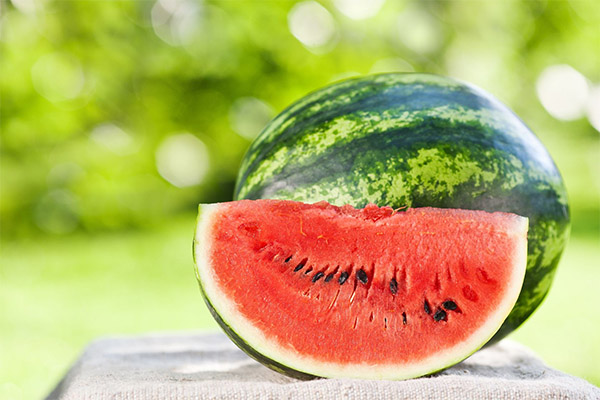
With diabetes
Watermelon contains a lot of carbohydrates. That is why with diabetes mellitus it is not recommended. Unless a person can refuse all other carbohydrates for the sake of one or two slices of watermelon. But the powder from the seeds, ground to a state of dust, just can be taken to normalize the level of sugar.
Important: the glycemic index of watermelon is 65-70 units.
With pancreatitis
During the period of exacerbation of this inflammatory disease, watermelon cannot be eaten, since the constituent substances cause severe irritation of the mucous membranes and only aggravate the course of the disease, since the pancreas also responds to this. In remission, you can use watermelon, but it is also advisable not in fresh form, but as jelly or other dessert that has been processed. The fact is that raw watermelon in any case will cause increased pancreatic activity, in this case completely redundant.
With gastritis
Since watermelon pulp stimulates the production of gastric juice, it is allowed for gastritis with low acidity. But at the same time, with gastritis with high acidity in the acute stage, it will be contraindicated because it exacerbates the situation. But in the remission stage, you can eat a small amount of pulp, and the one that is closer to the core and is sweeter. But it’s better to even eat not the pulp itself in its pure form, but drinks or jelly from it.
For the intestines
For the intestines, watermelon is useful in that the fiber, which is also in the pulp, as well as magnesium, enhances peristalsis, which contributes to the digestive process. But at the same time, if it increases the intestinal motor activity too much, which in the presence of its chronic diseases can lead to an exacerbation of the pathology and to severe diarrhea. So in the presence of such a predisposition clearly do not abuse watermelon, 200-250 g per day will be enough.
For constipation
A few slices of raw watermelon will be enough to establish the digestive process - and the first time.
With gout
This is an inflammatory disease that occurs due to impaired salt metabolism. Watermelon with this pathology is very useful - it does not contain purines, but it helps to restore metabolism and remove excess fluid and toxins from the body. With gout, it is recommended from time to time to arrange fasting days on a watermelon.
With colitis
This is an inflammatory bowel disease that can be aggravated due to irritation of the mucous membranes with acids that make up the watermelon. Therefore, with exacerbation of colitis, watermelon should not be consumed at all. And even during remission, care must be taken - no more than 200 g of pulp per day.
For the liver
Watermelon has detoxifying properties. It will help remove harmful substances from the liver. To do this, it is enough to eat 150-200 g of watermelon pulp throughout the season and observe a certain moderation in food. You can also arrange fasting days as noted above.
With hemorrhoids
With this disease, it is very important to avoid constipation. And with their prevention, the watermelon does an excellent job. It contains a lot of vitamin C, which strengthens blood vessels and helps fight those problems that lead to the development of the disease. Of course, the use of watermelon does not eliminate the need to do special gymnastics.
With cholecystitis
In the period of exacerbation of cholecystitis, watermelon is contraindicated, since it can only aggravate the situation.This also applies to cases where the disease is accompanied by the formation of stones in the bile duct. If cholecystitis is in remission, but there are no calculi, then you can eat up to 250 g of watermelon per day, but not all at once is better, but in two doses. So you can even reduce the symptoms of inflammation.
In case of poisoning
In case of poisoning with any foodstuff, therapeutic fasting is indicated, so watermelon should not be consumed in any case, even if it is known that it removes toxins. Sometimes it’s just a watermelon that can be poisoned, because it may contain nitrates.
If the cause of the poisoning was a watermelon, you must first provoke vomiting in order to get rid of toxins. After this, you need to drink Enterosgel for the normal functioning of the intestine and the removal of the last residues of harmful substances.
Watermelon in cosmetology
Given how many vitamins and minerals watermelon contains, it is not surprising that this large and sweet berry is widely used in cosmetology.

For face
There are many recipes for watermelon masks. Any of them will provide a healthy complexion and smoothness of the skin after just one application. The chemical composition of watermelon promotes hydration. In addition, its juicy and sweet pulp has an anti-inflammatory effect. To get the desired effect, you can do the following masks:
- Universal. You need to take the pulp from the middle of the watermelon to make a few small pieces, peel them from the seeds and literally rub each slice on the face skin with massaging movements. This mask can be kept on your face for 20-30 minutes, then rinse with warm water. Repeat the procedure once every three days. To check for an allergic reaction, you first need to apply a mask to your wrist or bend your elbow.
- Moisturizing. Take 1 tbsp. a spoonful of freshly squeezed watermelon juice, stir it with the same amount of purified water, soak gauze with this liquid and keep on your face for 15 minutes, then wash with cool water. You can use diluted watermelon juice as a tonic and wipe the skin twice a day, morning and evening.
- Matting. Shredded pulp of watermelon in equal proportions with starch and beat in a blender until the consistency of thick sour cream. Apply this mixture to your face for 15 minutes and then rinse with cool water.
- For normal skin. Take 1 teaspoon of honey, cottage cheese and chopped pulp of watermelon, mix until smooth, apply on face for 15 minutes, then rinse.
- For dry skin. Mix 1 tbsp. a spoonful of chopped watermelon pulp, 1 teaspoon of sour cream and the same amount of olive oil. Apply this composition to the skin for 10 minutes, then remove with a cotton pad soaked in green tea, and then wipe the face with an ice cube.
In the summer, skin can suffer from sunburn. A watermelon will also help to cope with this problem - only in this case it is not the flesh, but the crust, which should be cut into pieces, and then grind in a blender to a pulp consistency. This product can be used to lubricate areas of the skin affected by the sun.
For hair
Watermelon pulp is incredibly useful for hair, because it contains many valuable elements - amino acids, minerals, vitamins. For example, the already mentioned pigment lycopene protects hair from the harmful effects of ultraviolet rays, and niacin (one of the B vitamins) stimulates the renewal of their cells. Antioxidants such as vitamins A and E prevent dandruff. They also help fight hair loss, while B vitamins help restore their structure and growth. Calcium helps maintain their condition even after staining, and iron is necessary to nourish the bulbs and normalize metabolism.
There are several recipes for hair masks. For any of them, you need to take only a high-quality ripe fruit. In the simplest version, the mask is prepared from fresh pulp, which can be directly kneaded with your hands to the state of gruel.This tool must be applied to the hair along the entire length. If they are dry, then you need to deviate slightly from the roots, if greasy, then apply to the skin and roots. After that, you should put a plastic shower cap on your head, cover with a towel on top and let stand for 20 minutes. Then rinse with ordinary shampoo. Water should be warm, but not hot.
Harm and contraindications
Many believe that a quality watermelon will in no way do harm. In fact this is not true. Watermelon contains a lot of fiber, which improves intestinal motility. Magnesium has exactly the same effect, and it is also very much in the watermelon pulp. If a person has certain problems with the intestines, then consuming watermelon will only aggravate them, and at best, it will simply cause diarrhea. But this side effect is not as harmless as it seems, because it can lead to severe dehydration.
Also, watermelons are contraindicated for people suffering from chronic kidney disease or diabetes.
Symptoms of watermelon poisoning
As such, it is impossible to poison a watermelon, only the nitrates contained in it - these substances are used to make the berries grow faster and increase in size. In fact, nitrates do not always give an instant toxic effect. In people with fairly good health, they simply accumulate in the body for a long time. This leads to a decrease in immunity, weakness, sleep disturbances, insomnia.
But in young children, as well as in expectant mothers or in people suffering from diseases of the stomach and intestines, the effect will manifest itself very quickly. In this case, the symptoms of poisoning will be classic - nausea, to which vomiting, dizziness, and pain in the stomach are added in the near future.
Sometimes poisoning can be caused not by the presence of nitrates, but by improper storage conditions. For example, if there is a scratch or crack on the surface, then pathogenic microbes can penetrate inside, and from there they already go directly into the stomach, because the watermelon does not undergo heat treatment. That's why you need to choose these berries so carefully.
How to choose a ripe and sweet watermelon
An indicator that the watermelon grew on melon, and not in the greenhouse, is the presence of a yellowish spot on its surface - on this “side” the berry lay on the bed. At the same time, stripes should be clearly visible in the color of the watermelon. When squeezing, a crack should be heard, and the upper part of the peel should be easily removable, even if it is just slightly scratched with a fingernail.

In this case, the tail of the watermelon should be green and elastic, but not dry. By the way, if the tail is cut off, this may indicate that the seller did so on purpose to hide the quality of the goods. Many people remember that you first need to knock on a watermelon. A muffled sound indicates that the berry is overripe, and too loud that it is unripe. Ideally, there should be a booming sound that resembles vibration.
Of course, the buyer should first inspect the watermelon, check for cracks and damage. By the way, the peel of the watermelon should not be shiny. In ripe berries, it always has a slightly matte texture.
As for the shape and color, there are no longer such strict standards as before. In recent years, oblong, oval, even square watermelons have appeared on the market. And their taste can also be different, since different varieties differ among themselves in the amount of sugar.
Watermelon has a light and fresh smell. In quality berries, it is felt even through the peel. If there is no smell, this may indicate that in fact it was grown using chemicals.
How to check for nitrates
Theoretically, the buyer can demand from the seller documents confirming the quality of the watermelon. This can be invoices indicating the source of receipt, certificates proving safety, etc. Unfortunately, sellers on the market do not always have such documents. And without cutting a watermelon, it is almost impossible to check for the presence or absence of nitrates in it.
But, if the seller agrees to cut the watermelon, experts recommend paying attention to the presence of white seeds.The fact is that when using nitrates and other similar agricultural chemistry, the flesh ripens faster. But the action of these substances has practically no effect on the seeds. So if there are a lot of white seeds, then nitrates could be used to grow watermelon.
Also, experts advise to pay attention to the number of yellow and white veins in the watermelon pulp. If there are a lot of such veins, this suggests that when growing, nitrogen fertilizers, that is, nitrates, were used for top dressing, moreover, in an increased dosage.
By the way, a slice of a watermelon containing nitrates will be even and smooth. Berries that do not contain any harmful chemistry will always have grains on the cut.
How to store watermelon
The watermelon season does not last long, only 2-3 months, and even then not in all regions. However, high-quality ripe watermelons can be preserved until the winter - and even until the New Year. At the same time, ripeness is really very important, because, unlike other fruits, a watermelon can ripen only on melon.
If the task is to save the watermelon until the New Year, then you should not buy too large berries. The best option is watermelons weighing 4-5 kg. Moreover, it is best to buy berries of late varieties for long-term storage, many experts advise taking "Chill".
When choosing a watermelon, you need to pay maximum attention to the state of its peel. There should not be even minor damage on its surface. A barely noticeable scratch can adversely affect the shelf life. Therefore, you should not only carefully inspect the watermelon when buying, but also very carefully carry it home.
Watermelon needs to be prepared for storage. To do this, wash it in cold water and thoroughly wipe it with a towel or paper towel, and then dry it naturally.
It is believed that watermelon is best stored at a temperature of + 1–5 degrees Celsius. If the apartment is warm, then the fetus will be stored for two weeks, not longer. Better put it on a glazed loggia. In a private house, of course, it's easier, because there is a cellar - an ideal place. The main thing is to keep it dry.
It is believed that watermelon can not be stored on a solid surface, you must certainly put a soft towel under it. The room should not be too dry, for this berry you need normal humidity and good ventilation.
There are three main ways to store watermelon for a long time:
- Suspension is the easiest option, but at the same time effective. All that is needed for this is a durable canvas or linen bag. This sunny berry is put in it and suspended. You can’t use a plastic bag for these purposes, so the watermelon will deteriorate faster.
- Storage in sand is a more complex method, but no less effective. For this method, you will need a box, preferably a wooden one, into which dry river sand should be poured, and sifted so that it does not have large shells, pebbles and stones. This sand is poured onto the bottom of the box so that a kind of “pillow” 10 cm thick is obtained. A watermelon is laid on it so that its surface does not touch the walls. All empty space is covered with prepared sand. There is no need to ram it. Sand can be replaced with dry grain or dried straw (the latter is used for mass storage of melons and gourds). All these materials are needed in order to absorb excess moisture. In urban areas, it is easiest to get sand.
- Storage in water. Many housewives believe that this method is optimal, but in its pure form it can only be implemented if there is a private house. Indeed, in this case, you need to find a place in order to put there a container of water in which the watermelon will float freely. In such conditions, it will easily retain freshness for 4 months.
Some housewives recommend using cat litter instead of sand, but in reality these materials are not exactly identical in composition. In addition, it is unclear whether this remedy reacts with substances contained in watermelons or not.
Is it possible to freeze
Theoretically, watermelon pulp and juice can be frozen.But you need to understand that as a result of freezing, the flesh will lose its original structure. It will not be crispy and elastic, but it can be added to ice cream, desserts, smoothies and jellies. You can also make fruit ice.
The easiest way is to freeze in the form of cubes or balls. The watermelon will first need to be washed with cold water and wiped dry. To make it easier to process the pulp, it is better to cut the berry into four parts. Watermelon peels need to be cut - they can be processed separately. Remove the seeds from the pulp, they are used in folk medicine, so you do not need to throw them away.
If the pulp will be frozen in cubes, it should just be cut, if with balls - use a spoon for ice cream. Finished pieces should be laid out on a plastic cutting board or tray so that they do not touch each other, and then placed in the freezer for 2-4 hours. You can use the quick freeze mode if it is provided in the refrigerator. When the slices of watermelon freeze, separate them from the board with a wooden spatula and transfer to a plastic container or bag. They can be stored in the freezer for a year.
There are other ways. For example, you can freeze a watermelon with sugar. To do this, cut its pulp in the manner described above and pour the obtained pieces with ordinary sugar sand - not more than 200 g per 1 kg of pulp. Mix all this carefully with a spoon, put in a container and put in the freezer.
Slices of watermelon can be frozen in juice - peach or orange, to get a dessert with piquant notes. Slices of watermelon pulp just enough pour juice in a convenient form.
In a standard form for ice, you can also freeze directly watermelon juice obtained from pulp whipped in a blender. This ice, even in winter, can be added to desserts, cocktails or soft drinks.
How to eat a watermelon
Most often, a watermelon is cut into slices. But this is not always convenient, especially for children who often manage to get dirty so much. It is better to cut the crusts from these slices and cut them into cubes or just small pieces. If the watermelon itself is small, its pulp can be eaten with a spoon, cutting the berry into four parts. It will be most convenient for children.

How much can you eat per day
It is believed that for a person with healthy kidneys and normal metabolism, the maximum amount of watermelon that can be eaten during the day is 1 kg. However, for a child, especially a younger age, it should be about three times less. Again, the individual reaction of the body must be taken into account, and if the watermelon produces a strong diuretic effect, then reduce this amount.
Can I eat at night and on an empty stomach
You should not eat watermelon on an empty stomach. It irritates the mucous membranes of the stomach, and this causes dyspepsia and various unpleasant sensations. Theoretically, you can eat watermelons at night - this is not too high-calorie food. But they contain a lot of water and fiber, give a fairly strong diuretic and mild laxative effect. Therefore, in order to fully relax and sleep at night, it is better not to consume these berries after 6 pm.
Is it possible to eat watermelon seeds
Watermelon seeds are very useful - they contain arginine, B vitamins, minerals, etc. However, scientists say that these seeds are useful only if they are chewed properly, and not just swallowed. Of course, you can eat seeds simultaneously with the pulp, but in such cases it is not always possible to chew them, so most often they are eaten separately and dried.
Is it possible to eat watermelons in July
In most of the European territory of Russia, quality ripe watermelons appear only in the second half of August.But in sunny and hot summers, this can happen earlier - in early August. But those watermelons that appear on the shelves in July simply would not have time to ripen in the open ground, that is, on the melon. Their maturation was accelerated by the fact that they were placed under a film or originally grown in a greenhouse.
The problem is that with both open cultivation and greenhouse cultivation, nitrogen fertilizers, that is, nitrates, are introduced into the soil. But with natural ripening, these substances have time to disintegrate, and they do not enter the human body in the form of toxins. But with greenhouse cultivation this does not happen. And even if there were no symptoms of poisoning, all the same, these substances manage to get into the kidneys and liver, where they accumulate, leading to negative consequences over time. So with the purchase of watermelons it is better to wait until at least mid-August.
What can be made from watermelon: recipes
Watermelon is an almost universal berry. Firstly, it is good on its own, raw. Secondly, juice is made from it, and from this, in turn, a delicious watermelon ice is obtained, which can be added to any drinks. Summer watermelon is also made from watermelon, and alcoholic cocktails, and smoothies, and jelly, and sorbet. And, of course, it is added to fruit salads or served with creamy ice cream.
But not only desserts can be made from watermelon. It goes well with savory vegetables and cheese. For example, you can make a salad with watermelon, cucumbers, arugula and feta cheese. Or even a cold gazpacho soup of tomatoes and watermelons, whipping their pulp in a blender and adding green onions, basil and mint.
Jam
Many have tried jam from watermelon peels. But in fact, a delicious dessert can be obtained from the pulp of this berry. For jam, you need 0.7 kg of watermelon pulp per 1 kg of granulated sugar, 10 g of citric acid and vanilla sugar, since these berries do not have their own distinct flavor.
Watermelon needs to be washed, peel cut, peel the pulp from the seeds and cut it into not too small cubes. Put all this in a saucepan, basin or other container for cooking jam and pour it with sugar. To manage to stand out a sufficient amount of liquid, leave all this for a couple of hours. Then put the pot with juice and pulp on medium heat, bring to a boil and leave on medium heat for another 15 minutes, constantly stirring with a wooden spoon or spatula. Then remove from the stove and leave until completely cooled. Repeat this procedure three more times. At the last cooking, add citric acid and vanilla sugar to the already boiled and almost ready mass, cook for 15 minutes, then remove from heat, cool slightly and put it in prepared jars.
Compote
During heat treatment, the watermelon loses part of its healing properties, but there are still a lot of useful substances in it. And watermelon compote is stored longer than freshly squeezed juice. They prepare it like this - take 0.5 kg of watermelon pulp and 3-4 tbsp. Per 1 liter of water. tablespoons of sugar. Sugar is stirred in hot water, the pulp of watermelon cut into cubes is thrown into it (the bones are removed from there beforehand) and brought to a boil, and then immediately turned off to save more nutrients. Compote cool. It is better to serve it cold to the table or add ice cubes to it.
Ice cream
You can make fruit ice by freezing watermelon juice with mashed pulp. But you can make a full ice cream. To do this, 400 g of watermelon pulp will need 1 cup of 20% cream and 1 tbsp. a spoonful of powdered sugar.

Watermelon pulp is prepared as usual, removing seeds from it and cutting into pieces so that it fits in the blender bowl. After that, it is whipped in a smoothie, add cream and whipped again, already with a mixer, and long enough for the mass to turn out to be quite “fluffy” and airy. At the final stage, powdered sugar is poured into the mixture and beat again with a mixer, but at a low speed.
If desired, you can pour the resulting composition into molds (either ready-made, or in jars of yogurt) and stick wooden or plastic sticks in them. But, unfortunately, in this case, the texture will lose airiness, and ice crystals may appear in ice cream, so it is better to put it in a freezer in a plastic container.It is enough to hold in the freezer for 2.5 hours - the mass will have time to freeze sufficiently, but it can still be beaten with a mixer. After whipping, it is again put in the freezer for 2–2.5 hours. Dessert is served in a bowl, making balls with a special spoon for ice cream. You can decorate it with sprigs of mint and slices of fresh watermelon.
Wine
Since watermelon is a berry from which many non-alcoholic drinks are prepared, it is logical to assume that wine can also be made from it. True, it should be borne in mind that watermelon pulp is about 93% water, so a large amount of it is required. And you need to take more sugar. For example, a watermelon weighing 9 kg, in which the pulp will be about 1 kg less, will have to take 0.6–1 kg of sugar.
To make homemade wine you need to choose only the sweetest watermelons, otherwise the drink will seem strong. Table wine from these berries will not work, only strong sweet. Watermelon needs to be washed, cut off the peels, the flesh must be peeled. Moreover, you can only take red pulp, white parts will have to be ruthlessly thrown out. Grind the resulting raw materials in a blender, pour the juice into a prepared glass bottle and fill with sugar in the above proportion. However, the amount of sugar can be adjusted depending on how strong the wine they want to get.
Fermentation should be carried out in a dark place and at room temperature. You need to install a water lock on the bottle - that is, all this is done as usual in the process of preparing homemade wine. Some owners recommend to literally add a drop of ammonia to speed up the fermentation process, but it is better that everything happens naturally. When the fermentation process is completed, the wine must be filtered with gauze and bottled in prepared bottles. Usually the wine has a pink hue, sometimes a little reddish.
Pickled Watermelon in Jars
This unusual way of winter storage of watermelon is suitable for those who like to experiment. For cooking, take 2 kg of watermelon pulp, and crusts optionally cut, 1 liter of water, 70 ml of table vinegar, 3 tbsp. tablespoons of granulated sugar and 1.5 tbsp. tablespoons of fine salt. The water is brought to a boil, sugar and salt are added, stirred, left to simmer for another 10 minutes. Then remove the marinade blank from the stove, filter, add vinegar. At the same time, cut the watermelon in small pieces, so that it is convenient to place in a container, then put in prepared jars and pour the marinade. The workpiece is sterilized for 20 minutes, closed with a lid, turn the cans upside down and cool.
Is it possible to give animals a watermelon
You can give watermelon to dogs and cats - many pets themselves are drawn to it, because for them it is also an important source of vitamins and minerals, and they feel it. But you can give animals only pulp cut into pieces, with which the peels were cut and peeled. Otherwise, a stiffer crust surface can injure the esophagus or even the intestines.
Interesting facts about watermelon
It may seem that a watermelon is a berry of which everything is known. But scientists do not cease to be surprised at ever new discoveries. So watermelon is a very interesting berry. It can be considered completely edible. In China, they even learned to use absolutely all its parts. For example, the seeds are fried as described above, and not only sweet candied fruits are prepared from the crusts. They are also salted, pickled, stewed, turning into a light vegetable snack.
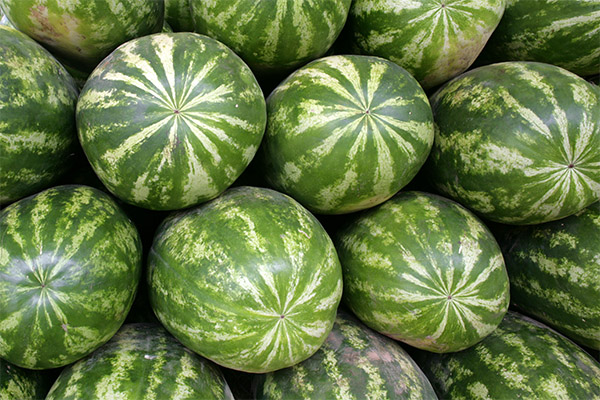
What else is interesting science tells about watermelon? Curious are the following facts:
- Although watermelon is a berry, it is also related not only to pumpkin, but also to cucumbers and zucchini.
- It is not known exactly where the cultivation of the watermelon occurred, but scientists are sure that it was South Africa.
- The oldest watermelon, the seeds of which were found in the excavations of the Lebanese settlement, was at least 5000 years old.
- Currently, watermelons are grown in 96 countries, the leaders are China and Turkey.
- There are more than 1,200 varieties of watermelons, most of them with red flesh, but with yellow and cream.
- Watermelon most often has a round or slightly oblong shape, however, square fruits were bred in Japan. It is believed that this was necessary so that the watermelons did not slide off the table. Square watermelons were first bred more than 30 years ago when the Japanese began to place the ovary in special translucent boxes of the appropriate shape. Then the fruit grew and took the form of a box. Today, such square watermelons are grown in Brazil, and in the Emirates, and even in England. At the same time, at present, technologies allow growing watermelons of another shape, for example, triangular, resembling a heart or even a human face.
- In Vietnam, watermelon is considered a symbol of the New Year, which is somewhat strange for residents of Russia. Watermelon according to Vietnamese beliefs brings good luck, and not only in material terms, but also in all areas of life.
- Watermelon is a natural antidepressant - its constituents contribute to the production of hormones of joy.
«Important: all information on the site is provided exclusively in fact-finding purposes. Before applying any recommendations, consult with a profile specialist. Neither the editors nor the authors are liable for any possible harm caused materials. "

